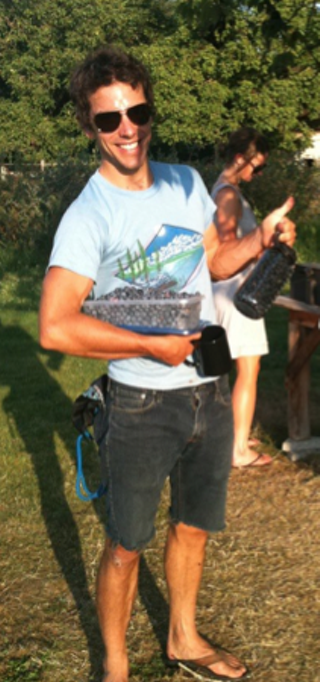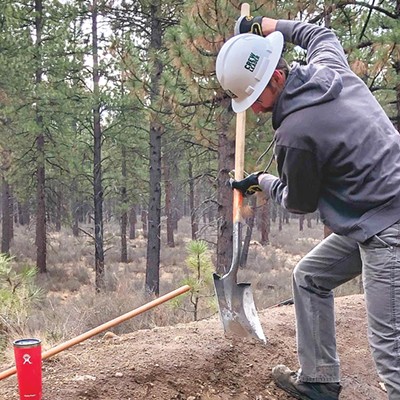Last Wednesday Pacific Power gave city and park district officials an exclusive tour of the beleaguered Newport Avenue Dam. A few media representatives were also allowed to tag along, but with a few caveats. First, we signed our lives away with a waiver and were required to wear steel-toed boots during the tour. Before entering the innards of the dam's powerhouse we donned blue fire-retardant jumpsuits to protect against any system malfunctions, which isn't an inconceivable notion considering the structure is 103-years-old and utilizes the sort of turn-of-the-century gadgets one might expect from the era. It was an enlightening experience, but one that seemed more like a quaint historical tour than a test drive.
But a test drive is what it effectively was.
Ever since late November, when Pacific Power announced that it was done with the leaking dam, Bend officials have been investigating whether it makes sense to take ownership of the structure. Owning the dam allows Bend to maintain Mirror Pond. This winter, a decision-making body called the Mirror Pond ad hoc group, made up of seven city and Bend Park & Recreation District representatives and two community members, decided to do just that—despite public opinion remaining split on whether to maintain the pond or explore other alternatives, like a free-flowing Deschutes River. The larger issue, though, is the massive silt build up behind the dam—a situation that has made for a shallow, weed-choked pond desperately in need of a fix. The recent tour (test drive) and ongoing negotiations with Pacific Power are part of the acquisition process, but despite all the (figurative) tire-kicking, myriad questions remain swirling around the silt, the river and the dam that impounds it all.
One of the equation's many factors, however, is clear.
"It's an old facility," said Bend City Councilor Victor Chudowsky, who also sits on the Mirror Pond ad hoc committee. "It appears to me to be kind of in a crumbling condition."
But appearances can be misleading. That's why the Mirror Pond group has commissioned an independent study of the dam. The independent inspection took place on Friday with results expected by month's end. Think of the inspection like taking a car to a mechanic before signing the papers and handing over the cash.
For Chudowsky, the inspection is more of an assessment of liability.
"10, 20, 30 years from now, is this thing going to cost us a large amount of money?," Chudowsky asked. "If it's really expensive, we'll look to the power company to dismantle it."
Some of the potential costs Chudowsky and others are worried about include ongoing dam maintenance or, should Bend decide to remove the impoundment, decommissioning costs. Similarly, state statutes that deal with transfer of ownership are as murky as the silt-filled pond. And what about the silt itself, which has been subjected to run off and other chemicals? As of yet, a study to determine the toxicity of the soil beneath the pond and around the dam has not been completed.
Mirror Pond project manager Jim Figurski said toxicity studies have been discussed but not scheduled. In general, he added, such studies are paid for by the landowner, in this case two Bend businessmen—Bill Smith and Todd Taylor—who this fall bought the mud beneath the pond.
"It generally falls in the category of due diligence," Figurski said of soil toxicity tests.
In the meantime, and despite the growing collection of question marks, negotiations with Pacific Power continue.
It's a comedic purchasing process, as both sides have exposed their respective hands. The Mirror Pond ad hoc group has made it clear it wants to keep the pond and, if at all possible, the dam. Pacific Power officials have outlined why they no longer want anything to do with the structure, which sprung another leak this past fall.
"The whole equation is it only produces so much power (enough for 300-400 homes)...when you start looking at making significant repairs, that's what puts the economics underwater," said Pacific Power spokesperson Bob Gravely during last week's dam tour.
A 2006 Deschutes River paddle trail and whitewater improvement feasibility study, commissioned by Bend Park & Rec., looked at what could be accomplished at the Newport Avenue dam site. The recommendation, made by a well-respected Boulder, Colorado-based recreation engineer, called for leaving the dam in place but allowing the river to bypass it and flow downstream over several tiered drops. Doing so would allow for increased recreation and upstream fish passage. And it would likely cost thousands, perhaps millions less than trying to patch a dam that's over a century old.
Others, like the Bend Paddle Trail Alliance, have floated thoughtful, modern alternatives for the downtown reach of the Deschutes River and ones that are steeped in compromise. The BPTA concept would maintain an upper pond but also allow for downstream travel and upstream fish movement. For some reason, these smart solutions have, so far, failed to gain traction with the Mirror Pond ad hoc group.
Jayson Bowerman, a BPTA board member, thinks a recreation- and environmentally-rooted solution will create greater engagement with and connectivity to the Deschutes River. Bowerman said he's witnessed such an effect in other towns, like Salida, Colorado, where officials have invested in river recreation and ecological protections.
"It's been relatively transformative in how young people come to use and view their natural environment," said Bowerman. "It breeds a respect for the river."



























